Why Do Nerve Impulses Not Continue Forever
11.4: Nerve Impulses
- Page ID
- 16784
This amazing cloud-to-surface lightning occurred when a difference in electrical charge built up in a cloud relative to the ground. When the buildup of charge was great enough, a sudden discharge of electricity occurred. A nerve impulse is similar to a lightning strike. Both a nerve impulse and a lightning strike occur because of differences in electrical charge, and both result in an electric current.
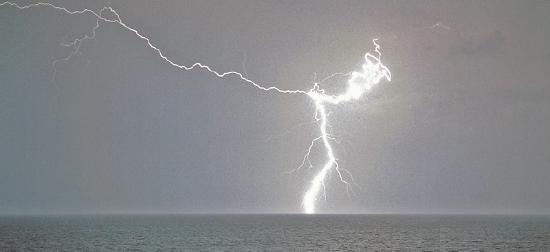
Generating Nerve Impulses
A nerve impulse, like a lightning strike, is an electrical phenomenon. A nerve impulse occurs because of a difference in electrical charge across the plasma membrane of a neuron. How does this difference in electrical charge come about? The answer involves ions, which are electrically charged atoms or molecules.
Resting Potential
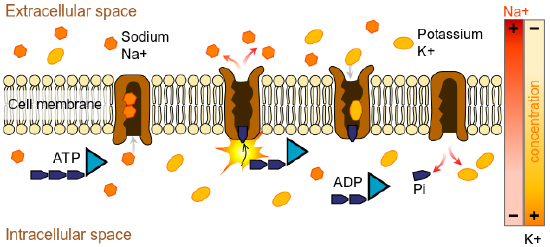
When a neuron is not actively transmitting a nerve impulse, it is in a resting state, ready to transmit a nerve impulse. During the resting state, the sodium-potassium pump maintains a difference in charge across the cell membrane of the neuron. The sodium-potassium pump is a mechanism of active transport that moves sodium ions out of cells and potassium ions into cells. The sodium-potassium pump moves both ions from areas of lower to higher concentration, using energy in ATP and carrier proteins in the cell membrane. Figure \(\PageIndex{3}\)shows in greater detail how the sodium-potassium pump works. Sodium is the principal ion in the fluid outside of cells, and potassium is the principal ion in the fluid inside of cells. These differences in concentration create an electrical gradient across the cell membrane, called resting potential. Tightly controlling membrane resting potential is critical for the transmission of nerve impulses.
Action Potential
An action potential, also called a nerve impulse, is an electrical charge that travels along the membrane of a neuron. It can be generated when a neuron's membrane potential is changed by chemical signals from a nearby cell. In an action potential, the cell membrane potential changes quickly from negative to positive as sodium ions flow into the cell through ion channels, while potassium ions flow out of the cell, as shown in Figure \(\PageIndex{3}\).
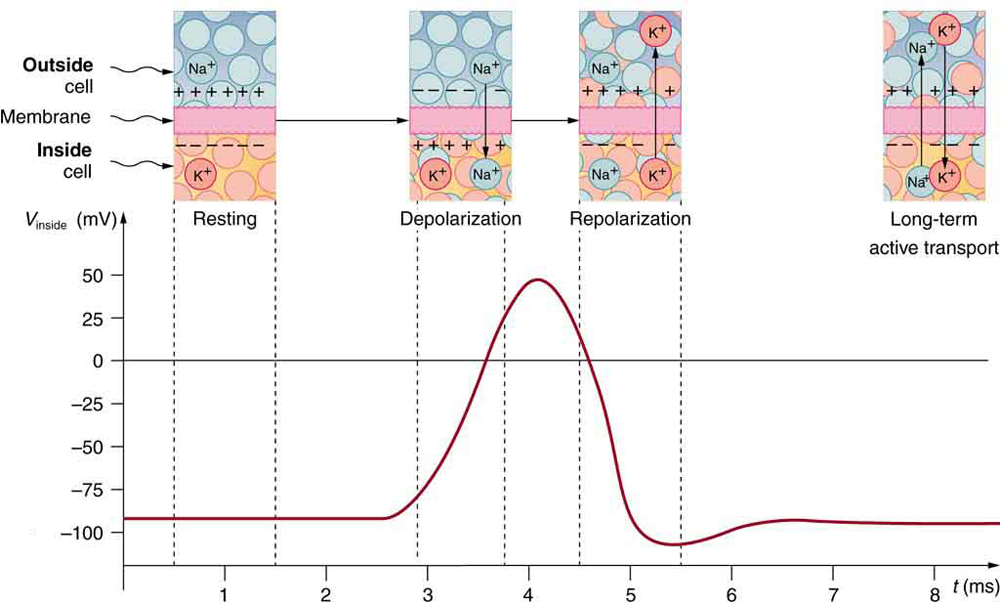
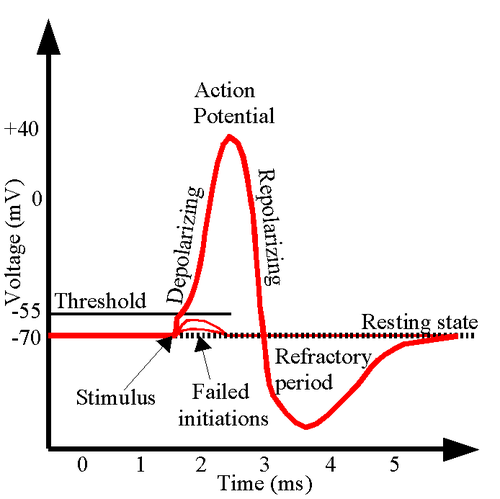
The change in membrane potential results in the cell becoming depolarized. An action potential works on an all-or-nothing basis. That is, the membrane potential has to reach a certain level of depolarization, called the threshold, otherwise, an action potential will not start. This threshold potential varies but is generally about 15 millivolts (mV) more positive than the cell's resting membrane potential. If a membrane depolarization does not reach the threshold level, an action potential will not happen. You can see in Figure \(\PageIndex{4}\) that two depolarizations did not reach the threshold level of -55mV.
The first channels to open are the sodium ion channels, which allow sodium ions to enter the cell. The resulting increase in positive charge inside the cell (up to about +40 mV) starts the action potential. This is called the depolarization of the membrane. Potassium ion channels then open, allowing potassium ions to flow out of the cell, which ends the action potential. The inside of the membrane becomes negative again. This is called repolarization of the membrane. Both of the ion channels then close, and the sodium-potassium pump restores the resting potential of -70 mV. The action potential will move down the axon toward the synapse like a wave would move along the surface of the water. Figure \(\PageIndex{4}\)shows the change in potential of the axon membrane during an action potential. The nerve goes through a brief refractory period before racing resting potential. During the refractory period, another action potential cannot be generated
In myelinated neurons, ion flows occur only at the nodes of Ranvier. As a result, the action potential signal "jumps" along the axon membrane from node to node rather than spreading smoothly along the membrane, as they do in axons that do not have a myelin sheath. This is due to a clustering of Na+ and K+ ion channels at the Nodes of Ranvier. Unmyelinated axons do not have nodes of Ranvier, and ion channels in these axons are spread over the entire membrane surface.
Transmitting Nerve Impulses
The place where an axon terminal meets another cell is called a synapse. This is where the transmission of a nerve impulse to another cell occurs. The cell that sends the nerve impulse is called the presynaptic cell, and the cell that receives the nerve impulse is called the postsynaptic cell.
Some synapses are purely electrical and make direct electrical connections between neurons. However, most synapses are chemical synapses. The transmission of nerve impulses across chemical synapses is more complex.
Chemical Synapses
At a chemical synapse, both the presynaptic and postsynaptic areas of the cells are full of the molecular machinery that is involved in the transmission of nerve impulses. As shown in Figure \(\PageIndex{5}\), the presynaptic area contains many tiny spherical vessels called synaptic vesicles that are packed with chemicals called neurotransmitters. When an action potential reaches the axon terminal of the presynaptic cell, it opens channels that allow calcium to enter the terminal. Calcium causes synaptic vesicles to fuse with the membrane, releasing their contents into the narrow space between the presynaptic and postsynaptic membranes. This area is called the synaptic cleft. The neurotransmitter molecules travel across the synaptic cleft and bind to receptors, which are proteins that are embedded in the membrane of the postsynaptic cell.
The effect of a neurotransmitter on a postsynaptic cell depends mainly on the type of receptors that it activates, making it possible for a particular neurotransmitter to have different effects on various target cells. A neurotransmitter might excite one set of target cells, inhibit others, and have complex modulatory effects on still others, depending on the type of receptors. However, some neurotransmitters have relatively consistent effects on other cells.
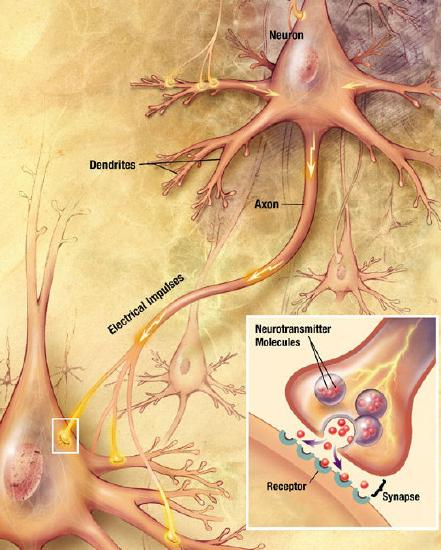
Review
- Define nerve impulse.
- What is the resting potential of a neuron, and how is it maintained?
- Explain how and why an action potential occurs.
- Outline how a signal is transmitted from a presynaptic cell to a postsynaptic cell at a chemical synapse.
- What generally determines the effects of a neurotransmitter on a postsynaptic cell?
- Identify three general types of effects neurotransmitters may have on postsynaptic cells.
- Explain how an electrical signal in a presynaptic neuron causes the transmission of a chemical signal at the synapse.
- The flow of which type of ion into the neuron results in an action potential?
- How do these ions get into the cell?
- What does this flow of ions do to the relative charge inside the neuron compared to the outside?
- The sodium-potassium pump:
- is activated by an action potential
- requires energy
- does not require energy
- pumps potassium ions out of cells
- True or False. Some action potentials are larger than others, depending on the amount of stimulation.
- True or False. Synaptic vesicles from the presynaptic cell enter the postsynaptic cell.
- True or False. An action potential in a presynaptic cell can ultimately cause the postsynaptic cell to become inhibited.
- Name three neurotransmitters.
Explore More
Source: https://bio.libretexts.org/Bookshelves/Human_Biology/Book:_Human_Biology_%28Wakim_and_Grewal%29/11:_Nervous_System/11.4:_Nerve_Impulses
0 Response to "Why Do Nerve Impulses Not Continue Forever"
Post a Comment